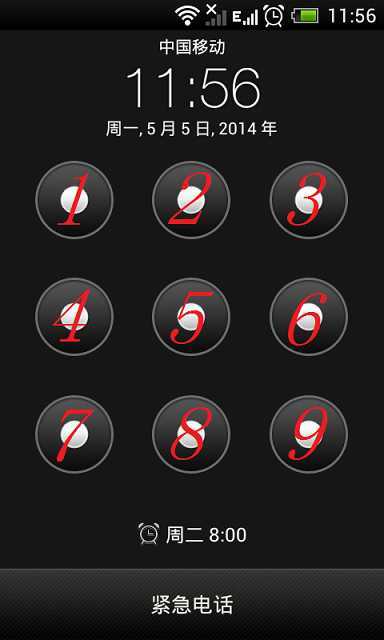标签:style blog class code java tar
如图所示的九宫格密码有多少种组合呢?这么密码是不是比数字密码更安全呢?下面用数字来说话。

通常设置密码至少4个点,最多9个点,规则通常是两点之间有一点,必须要过中间这个点,比如从1开始,必须要经过2才可以到3。1是可以直接到6的,但通常这种设置比较少。
运行附录的程序得到如下的数据:
size: 4 count0: 144 count1: 96 count2:40
size: 5
count0: 600 count1: 336 count2:152
size: 6 count0: 2880 count1: 1344
count2:304
size: 7 count0: 15120 count1: 4272 count2:496
size: 8 count0:
80640 count1: 18432 count2:1024
size: 9 count0: 362880 count1: 32256
count2:784
sum: count0: 462264 count1: 56736 count2:2800
use time:
453ms
例如:4个点组合可能有144种可能,排除飞点(1直接到3)的情况,剩下96种可能,如果不考虑跨点(1到6)的情况,仅剩下40种可能。
所以得出的结论是:4-9个点任意组合的九宫格有56736种组合,排除跨点的情况,有2800种可能。
一般人设置在5-7个点,通常形状并不复杂的可能性仅为1000种左右,试出来的可能性还是很大的,而使用4位数字密码的组合则为10000种左右。
源码附录:
package string; import java.security.InvalidParameterException; public class HowMany { public static void main(String[] args) { String[] except1 = new String[]{ "46", "64", "28", "82", "19", "91", "37", "73", "13", "31", "39", "93", "97", "79", "17", "71"}; String[] except2 = new String[]{ "16", "61", "18", "81", "34", "43", "38", "83", "72", "27", "76", "67", "92", "29", "94", "49"}; long lastTime = System.currentTimeMillis(); long sum0 = 0; long sum1 = 0; long sum2 = 0; for (int i = 4; i <= 9; i++) { long count0 = 0; long count1 = 0; long count2 = 0; for (int j = 1; j <= 10 - i; j++) { Combines num = new Combines(j, i); String str; boolean flag1 = false; boolean flag2 = false; do { flag1 = false; flag2 = false; str = num.getOne(); for (String except : except1) { if (str.contains(except)) { flag1 = true; break; } } for (String except : except2) { if (str.contains(except)) { flag2 = true; break; } } count0++; if (!flag1) { count1++; } if (!flag1 && !flag2) { count2++; //System.out.println(str); } } while (num.moveNext()); } sum0 += count0; sum1 += count1; sum2 += count2; System.out.println("size: " + i + " count0: " + count0 + " count1: " + count1 + " count2:" + count2); } System.out.println("sum: " + " count0: " + sum0 + " count1: " + sum1 + " count2:" + sum2); System.out.println("use time: " + (System.currentTimeMillis() - lastTime) + "ms"); } private static class Combines { private int base; private int[] number; private int[] poll; private long amount; private long count; public Combines(int start, int size) { if (size <= 1) { throw new InvalidParameterException(); } base = start; number = new int[size]; poll = new int[size]; amount = this.jieCheng(size); this.reset(); } public void reset() { initNumber(); initPoll(); count = 0; } public String getOne() { StringBuffer strBuf = new StringBuffer(); for (int i = 0; i < poll.length; i++) { strBuf.append(getNumber(poll[i])); } return strBuf.toString(); } public boolean moveNext() { if (++count < amount) { this.stepNext(1); this.initNumber(); return true; } else { return false; } } private long jieCheng(int x) { long y = 1; for (int i = 1; i <= x; i++) { y = y * i; } return y; } private int getNumber(int index) { int num; for (int i = 0; i < number.length; i++) { if (number[i] != 0) { if (index == 0) { num = number[i]; number[i] = 0; return num; } index--; } } return 0; } private void stepNext(int index) { if (poll[poll.length - 1 - index] == index) { this.stepNext(index + 1); poll[poll.length - 1 - index] = 0; } else { poll[poll.length - 1 - index]++; return; } } private void initNumber() { for (int i = 0; i < number.length; i++) { number[i] = i + base; } } private void initPoll() { for (int i = 0; i < poll.length; i++) { poll[i] = 0; } } } }
解锁图案-九宫格有多少种组合?安全吗?用程序来解答,布布扣,bubuko.com
标签:style blog class code java tar
原文地址:http://www.cnblogs.com/Efronc/p/3709360.html